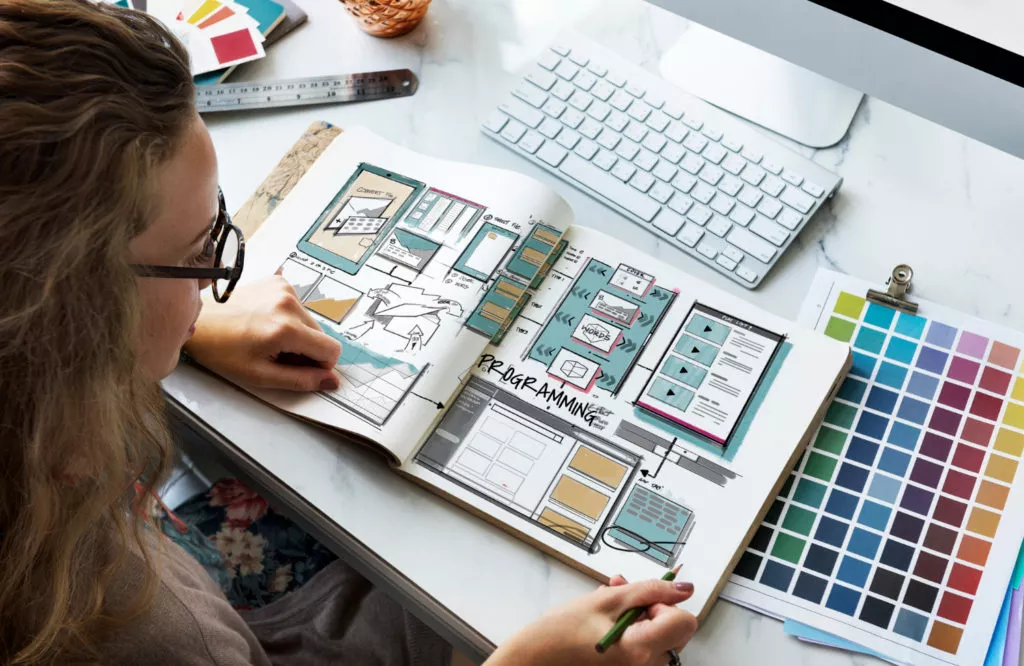As a UX/UI designer, you're constantly learning and evolving. Technology changes rapidly, so you feel the pressure to keep up. While there's no age limit on learning, continuous development separates good designers from the mediocre.
One way to stay ahead of the curve is to learn design courses. Skill Success offers a variety of courses that will help you master the latest trends and techniques in UX/UI design.
Moreover, to ensure you create applications that are visually stimulating, attractive, and aligned with business goals, it's essential to challenge your existing practices. In this article, we'll discuss various ways to step up your UX/UI design game.

10 Ways to successfully build your UX/UI design skills online
If you want to stay in line with technological innovations, it's more than essential to step out of your comfort zone, refine your skills and deliver applications that encourage a user to use them repeatedly. Here are 10 ways to build your UX/UI design skills:
1. Invest in online learning courses
Did you know that UX designer was one of the 50 Best Jobs in America for 2022 based on earning and job satisfaction? These statistics make it even more essential to break out of your old mold and improve your skills.
One great way to improve your skill set is by investing in popular and reputed online learning courses. You probably cannot progress in your UX career and expect a higher salary without enrolling in an online course.
With many online courses available, choose one that suits your learning curve and ensures that you do not stagnate in your career.
After completing a course, if you wish to know whether you're progressing in your career, visit UXcel's designer salary guide to know how much salary you deserve depending upon your experience and skill.
2. Copy top designers
At first glance, copying might seem unethical, but it's a beneficial tactic for UI designers to learn and improve. Wondering how?
Copying designs of top designers is all about reverse engineering. When you attempt to recreate the work of other designers, you come out of your comfort zone and practice different approaches to UI design.
However, don't confuse copying others' work with plagiarism. You're safe if you're using these designs for learning purposes and not selling them to others or showing them in your portfolio.
Copying top UX/UI designers is no longer a nightmare; it's a reverse engineering process that helps you improve your skill set.
3. Learn different UI design patterns
UI design patterns are a design blueprint that helps a designer choose an ideal interface for the specific context based on the design requirement.
It primarily serves as a language for designers, which might keep misunderstanding at bay and ensure consistency when multiple designers work on the same project.
These design patterns are standard reference points that empower designers to improve their efficiency and increase the chances of solving a problem when designing an app.
Learning different UI design patterns ensures you do not reinvent the wheel whenever you encounter a design issue.
4. Develop a keen eye for good UX/UI design
Learning the fundamentals of good UX/UI design might help you overcome only a few obstacles in your UX/UI design journey. To improve your UX/UI design skills, surround yourself with the good design of websites and mobile apps.
Training your eye for good design helps you stay inspired daily. To surround yourself with good design, visit your favorite website or check designs on websites like Pinterest.
Understand how other designers use typography, colors, spacing, white spaces, and other design elements. Save design and bookmark websites that you find intriguing and innovative. This helps you create your design innovation library, which you refer to when creating a design for a client. For instance, use Behance to showcase creative work.
Developing a strong visual eye for design is essential for improving your skills. Have a good eye for design, keep up-to-date with trending UX/UI designs, and get creative inspiration from the trends.
5. Implement your learning
After completing an online course and reverse-engineering the work of top designers, it's essential to test and implement your learning.
Implementing your learning into real-world projects helps you improve your skills. Even if you don't have any project, start working on a fake or a dummy project. This ensures you implement all your learnings as soon as possible.
While implementing your learning, try to work on multiple UX/UI design projects so that you easily juggle between them. When you get stuck with one project, move to another one and back to the one you left earlier.

6. Attend online webinars
While an online course clears your fundamentals and improves your skill, attending online webinars helps you interact with experienced professionals.
Webinars are a great way to gain knowledge and upskill and are an excellent resource for information. The way an experienced professional explains a concept in a webinar is much more intimate than in online courses.
Webinars are similar to personal sessions, where you ask questions, share your feedback, and connect with like-minded professionals. This makes webinars unique and offers various functionalities that steer your UX/UI ship in the right direction.
7. Develop your professional network online
Whether you work as a freelance or full-time UX/UI designer, take a few steps in the right direction by attending local networking events. It's a transformative move for your career as the more your network, the more you connect with experienced professionals who guide you.
Building a strong network helps you discuss solutions to common design issues and exchange tips and tricks for becoming a better designer.
Also, through networking, you might realize that many UX/UI designers face the same challenges and roadblocks that you might be facing.
8. Seek online feedback from professionals
Perfecting your design drives many UX/UI designers insane, and as a result, some of these designs might never see the light and get dumped in the recycle bin. To ensure you don't fall prey to pixel perfectionism, focus on sharing your work with other designers to get their feedback on your design.
Apart from helping you gain a fresh perspective, these feedbacks help improve your design and ensure it resonates with your target audience.
However, never feel that asking for feedback is a sign of a vulnerable designer. Interestingly, some of the top and respected designers got to where they are today by happily accepting criticism. Remember that constructive criticism given by professional critiques is pure gold as it helps you enhance your skill set.
Interestingly, if you're an experienced UI/UX designer, don't hesitate to give critiques to someone's work, as it improves your visual skills. When reviewing others' work, you get to revisit your fundamentals.
9. Practice while reading online
As Dale Carnegie once said, “Learning is an active process” and this statement holds as humans learn by doing things. Humans remember information that they use.
The knowledge a designer has increases when they practice while reading or learning a concept. Without practice it goes waste as the mind cannot recollect the information.
For instance, if you read an online book about font pairing, focus on practicing it before moving to the next concept. As you read, open Pinterest or Behance and search for designs depicting font pairing.
While reading theory books strengthens your fundamentals, you learn better by looking at examples. This is because humans process visual information 60,000 times better than text.
10. Try some new online tools
Another great way to improve your UX/UI designer skills is by learning new tools. Besides offering career benefits, it enhances your skillset and ensures you learn a new UI/UX design tool.
When you decide to learn something new, it primarily shows your ability to adapt to new design processes. For instance, choose a new wireframing package to adapt to new processes. Learning a new wireframe means the ability to create intuitive and user-friendly applications.

Key takeaways
As a UX/UI designer, if you develop an identifiable style and your work portfolio looks stale and boring, it's probably time to tighten your seat belts and improve your skill set.
As trends come and go, and when you use obsolete technology, your work no longer comes across as out-of-the-box. That's the time when you need to focus on improving your skill set.
As a designer, never stop striving for self-improvement, as it will ensure a successful career. While there is no short-cut or dedicated recipe for improving your UX/UI design skills, these methods help you improve.
Dedication and hard work might make it easy to enhance your skill set.
To support your ongoing journey, invest in Skill Success All Access Pass. With this membership, you unlock a treasure chest of valuable resources that fuel your creative growth.
Don't wait, subscribe today and unlock your full potential as a designer!


